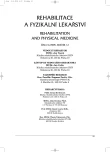Automatic Measurement of Muscular Strenth and Edurance Results of Kinesitherapy
SAMOČINNÝ SILOMĚR PRO HODNOCENÍ ÚČINKŮ KINEZITERAPIE
Svalová síla a výdrž jsou ukazatele velmi užitečné v hodnocení výsledku kineziterapie. Doposud převládají manuální metody vyšetřování jednotlivých svalů a svalových skupin. Práce uvádí popis jednoduchého elektromechanického siloměru, napojeného na počítač, který automaticky měří oba zmíněné parametry. Provedené klinické zkoušky potvrzují užitečnost tohoto zařízení v rehabilitační praxi. Výsledky ukazují na svalovou výdrž jako slibné měřítko postupu léčby.
Authors:
A. Dyszkiewicz 1,2,3; K. Imielski 2,3
Authors‘ workplace:
Institut informatiky Slezské univerzity, Sosnowiec, Polsko
1; Laboratorium biotechnologií, Cieszyn, Polsko
2; Nestátní zdravotnické zařízení „Vis“, Cieszyn, Polsko
3
Published in:
Rehabil. fyz. Lék., 12, 2005, No. 2, pp. 72-75.
Category:
Original Papers
Overview
Muscular strength and endurance are good tests of the results of kinesitherapy. Sofar methods of manual testing of individual muscles and muscle groups prevail. The paper describes a simple electronic measuring device connected to a computer, which measures both strength and endurance. The value of this device in clinical practice and for the assessment of the effectiveness of rehabilitation are shown. The results demonstrate muscular endurance to be most valuable to assess the results of treatment.
Key words:
measuring, edurance, kinesitherapy
Labels
Physiotherapist, university degree Rehabilitation Sports medicineArticle was published in
Rehabilitation & Physical Medicine

2005 Issue 2
- Hope Awakens with Early Diagnosis of Parkinson's Disease Based on Skin Odor
- Deep stimulation of the globus pallidus improved clinical symptoms in a patient with refractory parkinsonism and genetic mutation
Most read in this issue
- Painful Dysfunction Syndromes of the Shoulder: The Role of Short Depressors of the Humeral Head
- Standing up from the Sitting Position in Clinical Practice
- McKenzie Mechanical Diagnosis of Functional Syndromes of the Musculoskeletal System
- Dynamics of Functional Muscle Changes in Young Tennis Players
